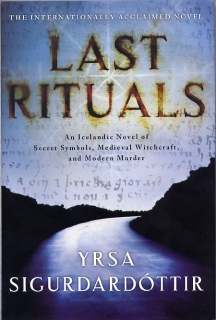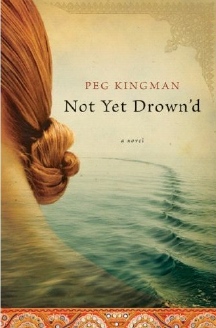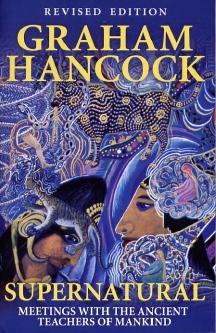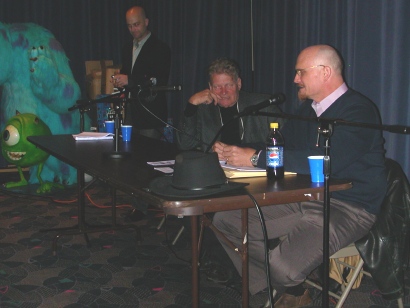|
|
|
|
This Just In...News
From The Agony Column
|
|
09-28-07: Ysra Sigurdardottir Examines 'Last
Rituals' ; Agony Column Podcast News : James Hughes, At Singularity Summit
|
"Burn him! Wait, him?"
|
|
Cold
hearts and minds, watching.
|
Ysra Sigurdardottir tells
us that there is a "depressing lack of crime" in
Iceland. But that didn't stop her from writing 'Last Rituals' (William
Morrow / Random House ; October 2, 2007 ; $23.95). "A mere 300,000
people live in Iceland and crimes are relatively few and far between.
This is quite a good state of affairs for the general public, but extremely
depressing for a crime writer, especially considering the fact that the
few crimes committed are excruciatingly boring."
Which is quite unlike her novel. Imagination wedded with actual history
make short work of any potential boredom for her readers. 'Last Rituals'
begins when Thóra Gudmundsdottir, a struggling attorney, agrees
to investigate the death of a German student. His family doesn't think
it's down to the local drug dealer the cops have in the nick. They want
someone who can speak Gertman – Thóra, and they're willing
to pay double her rate, so all's good, well, except for the murder victim,
Harald Guntleib.
But even when he was alive, things weren't so peachy for Harald. His murder
was sort of spectacular, not just a dead body with a neat hole in the forehead.
And it turns out he was on a quest for a book we’ve mentioned here
before, the Maleus Maleficarum. Yes, the good ol' Witch Hammer figures
in the plot once again. Harald, it seems was part of a group fascinated
with black magic, and as such, in the world of you-deserve-it murder mysteries,
he's toast. No, more like steak tartare, but maybe not so finely chopped.
How do you find the murderer of a young man obsessed with magic and witch
hunts? Looking to local history is a good guide, and the complicating fact
is that just like the US, Iceland had its share of witch hunts – most
of which sought out men. And many of which took place in now-hip Reykjavik.
Sigurdardottir writes with a light hand and grounds her story in the struggles
of her heroine, a single mother, new attorney, new at everything, So hunting
witch hunter killers is just another new thing, only bloodier. And probably
more dangerous than being a new mother, though that's arguable. What's
not is that readers looking for crime fiction with an evocative setting
and an at least tangential connection to the supernatural can find in 'Last
Rituals' the first book in a potentially interesting new series. We're
told she's already at work on 'My Soul to Take', the second Thóra
Gudmundsdottir mystery. Obviously, a depressing lack of crime does not
impact Sigurdardottir's chilly imagination.
|
Agony Column Podcast News : James Hughes, At
Singularity Summit : Sharia AI
Today's podcast
features James Hughes from the Singularity Summit on the ethics of
AI. Wild and fascinating Speculation about Sharia AI, and deciding
when robots can kill. Here's
the MP3 link. Watch out, Hughes is just
fantastic and may have you pulling over to the side of the road in
wonder.
|
| |
|
09-27-07: A Review of 'The Great Man' by Kate
Christensen ; Agony Column Podcast News Report : A Conversation With Bookseller
Jack Rems
|
Portrait of the Absence as an Old Man
|
|
| Painted
with bold strokes of prose. |
Today, I have a
review of the new novel by Kate Christensen, 'The Great Man'. I'm prone to bits
of bitterness that inspire one friend to urge
me to start "The Bile File" as a regular feature here. That
love of my own bitter nature makes Christensen's work consistently enjoyable.
'The Great Man' is a very funny book, so long as you have a slightly
sour disposition and an interest in affairs of the heart both good and
bad. Christensen's work puts you in the lives of four fascinating elderly
women while it lacerates just about everyone in sight. The author has
clearly fallen in love with her characters and readers will as will.
The four elderly women who were once in the orbit of "The Great
Man" all know, but never say that he was really just a womanizing
lout smart enough to surround himself with great women. Readers who relish
a sit down with the witty, the smart and the tart will find a feast here – and
recipes
on the author's website to compliment said reading delights.
|
Agony Column Podcast News Report : A Conversation
With Bookseller Jack Rems : 31 Years of Dark Carnival
Today's podcast is a conversation with Jack Rems, who has owned and operated
Dark Carnival Books in Berkeley for THIRTY-ONE YEARS. Here's
a link to the MP3 file. Think about that; thirty-one years of owning a specialty
bookstore. The mind boggles, and not just at the SF content that the bookstore
carries.
|
| |
|
09-26-07: H. P. Lovecraft Revises 'The Horror
in the Museum' ; Agony Column Podcast News : A Conversation With Peg Kingman
: 30 Years / 7 Years / 2 1/2 Weeks to 'Not Yet Drown'd'
|
X-Mart Arkham House
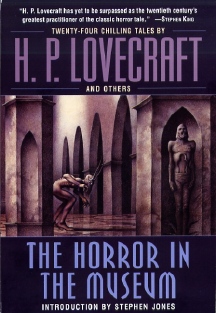 |
|
| Cover
art by John Jude Palencar. |
We all have to discover H.
P. Lovecraft in our own way. I first read about
him in the back of a Groff Conklin anthology that claimed to contain
the '17 Great Science Fiction Stories'. Lovecraft was listed in an appendix,
and I found the infamous burning-skull Lancer paperback in the same liquor
store where I had found the Conklin anthology. 'The Colour Out of Space'
wasn't quite as alluring as the Mickey Spillane paperbacks with their
torrid covers, but it did in fact change my reading life forever.
That was longer ago than I'd care to admit, and things have sort-of gotten
better. Alas, the corner liquor store no longer (needs to) carry a paperback
book inventory. For the kind of cheese I'm talking about, you’d have
to go to one of the Marts, and they won’t even have the best stuff,
the sleazy covered Pbs from Hard Case.
But if you're lucky, you might find 'The Horror in the Museum' (Del Rey
/ Random House ; September 25, 2007 ; $16.95). I'd suggest that you try
your local independent bookseller, but if you want the sleaze experience,
then these days, X-Mart will have to do. Oh, the humanity.
At least Del Rey is fighting the good fight, keeping Lovecraft in print – sort
of. 'The Horror in the Museum' is not exactly a Lovecraft collection, but
a collection of stories he revised for other authors. As such, it's not
actually even his work – , but for this reader, there is something
about all Lovecraft and his related authors that is simply appealing. This
horror fiction, designed to disturb us to our souls, is my comfort reading,
that to which I can return like an old friend. If you've read Lovecraft,
but not these stories, you'll probably want to pick this up to fill in
the corners of reading as the fall arrives and the streets grow dark. And
even if you own the Arkham House first edition, it's old enough to have
kids in high school (say Scott Sigler, whose work I think Lovecraft would
enjoy), and should probably live in your rare books room. You do have a
rare books room, right?
Good. Then move the Arkham house over there, and pop this trade paperback
in its place. You do get a disturbingly beautiful cover by John Jude Palencar
and an additional introduction from Steve "Mammoth Book of Horror" Jones.
The print is decent but the pages are cheesy. If only, if only they could
make them purple, like the Lancer edition. Are you listening Del Rey? Bring
back our purple-edged pages. I'm pretty sure you'll move more units through
the Marts with purple pages. It certainly matches the prose!
|
Agony Column Podcast News : A Conversation With
Peg Kingman : 30 Years / 7 Years / 2 1/2 Weeks to 'Not Yet Drown'd'
|
|
A
nice cover for a debut novel.
|
Today's podcast is a quick conversation with debut author Peg Kingman.
Her novel, 'Not Yet Drown'd' combines history, mystery and romance; it's
set in India and Scotland in 1821. You can listen
to the MP3 from this link or subscribe to the podcast from iTunes.
|
| |
| |
|
09-25-07: Whitley Strieber Makes a Date for '2012' & Graham
Hancock Gets 'Supernatural'; Agony Column Podcast News : Avoiding Death
With Owen Egerton
|
Two Paths to Human
We're just now figuring out what makes us human. At least we've just started
writing about it.
Not that the subject hasn’t been the eternal subject of literature,
of all art, really. But sometimes science drives the art, and something
we learn gives us a new perspective. In this case, it's cave drawings in
Southern France. Art itself now defines humanity.
'Supernatural' (Disinformation Company ; October 20097 ; $18.95) by Graham
Hancock and '2012: The War for Souls' ( Tor / Tom Doherty Books ; September
18, 2007 ; $24.95) by Whitley Strieber purport to tell us what makes us
human. Hancock's work is non-fiction, while Whitley Strieber's is science
fiction. What interests me as a reader is that both books hark back to
changes in human behavior that took place between 30,000 and 50,000 years
ago. Hancock asks why and explore the subject scientifically; Strieber
asks why and explores the subject with his imagination. But both writers
agree that it wasn't simply happenstance that brought about this change.
To put it bluntly, it was beings from the Otherworld meddling about in
not-yet-human affairs.
Hancock's book is a paperback re-print of the hardcover issued last year,
with a pretty major change, that is, the deletion of SEVEN CHAPTERS of
(and I quote Hancock himself here, from an author's note) of "overly
academic" (read: boring to the great unwashed) material focused
on Professor David Lewis-Williams' neuropsychological theory of cave
art.
This material has been replaced with a single chapter précis that
folds more reasonably into the overall thrust of 'Supernatural'. So this
is somewhat frustrating; I would have preferred to have the elided material
included as an appendix, but I can see why it was not. At 453 pages,
'Supernatural' is already on the long side. Seven more chapters, even
as an appendix might
have scared readers away. If you want both versions, and you might,
then you'll want to buy both. Hrumph.
But they shouldn't be scared because Hancock is an engaging writer. He
dives right in where angels, or at least the sort of scientists who publish
in Nature fear to tread, but the places he goes at least interesting to
read about. 'Supernatural' starts off with Hancock supine on a couch slowly
watching reality melt under the influence of ibogaine, a drug derived from
the iboga or eboka plant, a favorite of central African shamans. It's illegal
in the US, but in the UK, where Hancock lives and writes, they've opened
up access because, well – maybe it helped us become human.
Sounds reasonable to me.
Hancock's pursuit of the moments that made us human leads him around the
world, from France, Spain and Italy to South Africa and eventually the
Amazon. 'Supernatural' posits that the glimpses given by drugs such as
ibogaine and Ayahuasca from the Amazon rainforest are not simply hallucinations,
but visions of an actual Otherworld peopled by entities that had a vested
interest in seeing the cave apes become human, and that the path we were
set upon was not the result of random chance but part of a plan. The Gods
Must Be Art Collectors, and why not? Are not the books we write and read,
the paintings and music we create the summit of human endeavor? Hancock
may or may not convince you that his thesis correlates with the world out
there, but he's certainly going to make you think and think deeply about
what it means to be human.
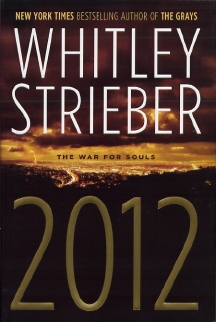 |
|
| Geddy
Lee, man. Geddy Lee. |
Whitley Strieber
is no stranger to this territory, and he presents a pretty straightforward
thriller-ized version of the same ideas. Basically, in
2012, the year we first heard about from Rush so long ago – so, so
long ago – the same critters that nudged us into the habit of painting
back when we were cave apes make another appearance, this time with less
salubrious goal. On 12-21-2012, sacred sites around the world become
roach motels for human souls. Not human bodies, mind you, whatever's
doing this
has no need for the flesh. Of course, this upsets HUMAN CIVILIZATION,
because it might like, end. What follows is a big enough disaster to
attract the
likes of motion picture director Michael Bay (Armageddon), who was and
still is purported to have an interest in bringing it to the big screen.
Whether or not it ever gets there is may well depend on the very critters
that both writers are alluding to.
Strieber will not knock you off your feet with profundity but he does
provide a toe-tapping apocalypse in the standard 300-something pages
format. You
read this in a weekend and forget it by the next weekend, unless you
read it in conjunction with Hancock's book, which is much more likely
to stick
in your brain. We creative, engaged humans have uses for both modes of
thought. Hancock wants us to reconsider how we became what we are and
he works on the fringes of both literary and scientific thought. But
he's
serious, skilled, smart and quite compelling. Strieber takes some of
the same ideas and recombines them to make us forget who we are for a
few moments.
Strieber is also serious – about entertaining us, about helping
us excape from where we are. We need both. We are, after all, only human.
|
Agony Column Podcast News : Avoiding Death With Owen Egerton
: Scrubbing the Wordscape
Today's podcast
is a conversation with Owen Egerton, whose book is 'How best to Avoid
Dying'.
He and I talked about how he writes so fast that
his first drafts are filled with nonsense words, and how he takes a lot
of inspiration fro his visits to the midnight movies at the Alamo Drafthouse,
often brought there by Ain't it
Cool News maven Harry Knowles. You can
hear the MP3 right
from this link, or subscribe to the podcast from iTunes. "Humor
has this ability to kind of, twist our perspective," he told me.
Twisted is often the best thing we can say about the world around us.
|
| |
|
09-24-07 : The Pixel-Stained Technopeasant Wretch Debate
|
Tachyon Publications Presents SF in SF
|
|
Scott
Sigler, Terrry Bisson and Howard V. Hendrix. |
Shortly after I
decided to engage in daily podcasting, I
talked with Alan Beatts, the owner of
Borderlands Books in San Francisco. After our
interview I asked him if he had any suggestions where I might gather
audio to fill my new schedule. He suggested that I get in touch with Tachyon
Publications, which was hosting a monthly "SF
in SF" show
at the Variety Theater in the Hobart Building on Market Street in San
Francisco. I already knew about the shows and had been intending to attend,
but this lit a fire. I emailed Rina Weisman, and working with her, obtained
permission to record and podcast last week's "SF in SF" show,
the titular "Pixel-Stained
Technopeasant Wretch Debate", which
I first saw mentioned in this Boing Boing post. The participants included
Scott Sigler, author of 'Ancestor' and Howard
V. Hendrix, author of 'empty
cities of the full moon', moderated by Terry
Bisson.
Here's the short story behind this discussion. On April 24 of this year,
Howard Hendrix
posted what he himself described as a "rant" about "webscabs,
who post their creations for free," to the SFWA LiveJournal Community.
As you might imagine, this enraged a lot of people; author Jo
Walton declared April 23 to be International Pixel-Stained Technopeasant
Day.
Cut to September 19, and you find Scott Sigler – who made his career
by podcasting his novels for free – on stage with Hendrix for the
SF in SF event, with Terry Bisson between them. All for free in a to-die-for
setting, and I mean to-die-for. I almost killed myself trying to find
a parking space after practically driving up on the curb to park illegally
while I dropped off the sound gear for the show. I provided the mixer,
speakers and mics to ensure the best possible recording.
What's nice about these events is the focus on literature. After a brief
introduction by Rina Weisman of Tachyon Publications, and Ellen Goodman,
Executive director of Variety Children's
Charity of Northern California (who provide the venue, thank them and contribute), Bisson started the
proceedings with a meaty reading by each of the participants. Sigler
went first, reading from his forthcoming-in-hardcover novel 'Infection',
which is (from what we heard) apparently powerful enough to infect the
author himself who later joked about podcasting from the tubercular ward.
Bisson turned things over to Hendrix, who read a new story, 'Flame of
Branches'. That took care of the first hour of the show, followed by
a brief break.
When the participants returned, the debate, really a wide-ranging, polite
and very erudite conversation, ensued. You can hear it for yourself here
in MP3,
and here in RealAudio. (I'm aware of the irony, but the Monday podcasts
traditionally go out in both formats – and this one is long, over
an hour.) Next Tuesday I'll podcast Sigler's reading, and next Wednesday,
Hendrix's. I'm definitely hooked on the SF in SF productions and schedule
/ authors permitting, will continue to provide sound and podcast them.
Upcoming events include Kage Baker and Eliot Fintushel for Sat. Oct.
20th, and Karen Joy Fowler and Molly Gloss, on Sat. Nov. 17th. How I'll
fill the days in between – well, that's something we'll both find
out.
|
| |
|
|



